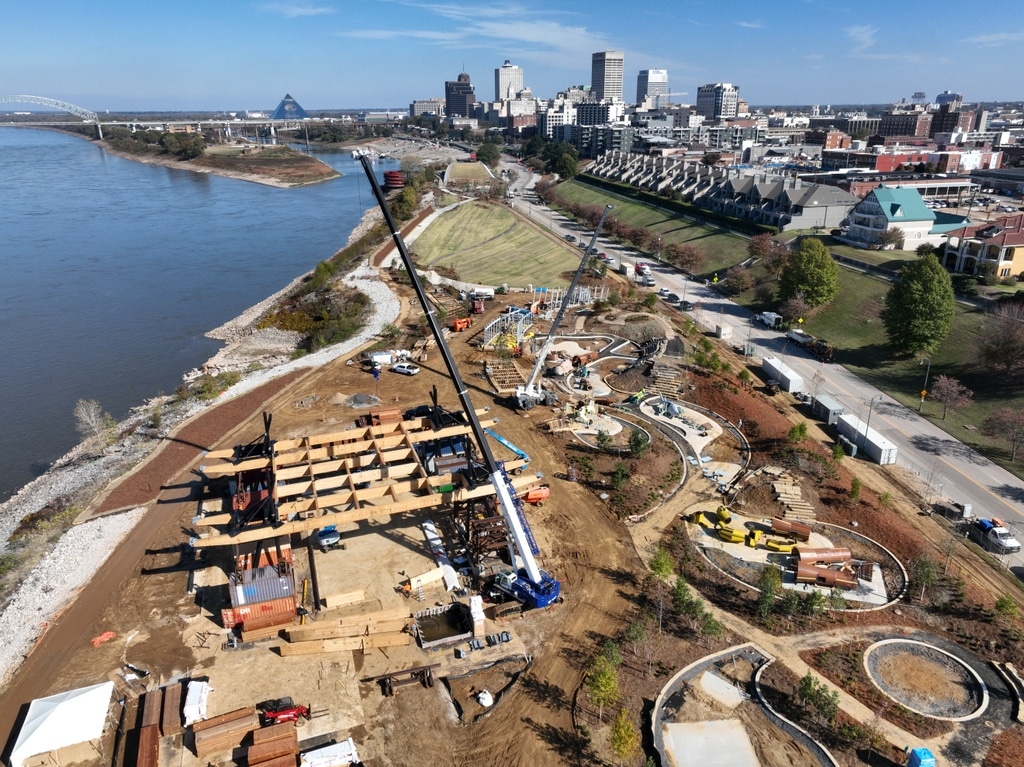One of America’s largest timber manufacturers, Timberlab, has opened its new 75,000-square-foot glulam facility in Greenville, South Carolina—the second on the site—solving a blockage in the supply of tall timber projects across the American South and East Coast. The new plant, operational since April, is critical in Timberlab’s push to drive adoption across the East Coast, the United States’ next frontier for mass timber construction.
“There is an existing network of timber suppliers and glulam manufacturers in the Southeast that have been operating for decades with limited opportunities to deploy their product,” according to Timberlab’s President Chris Evans. “We intend to expand the supply chain and, thereby, reduce the cost of mass timber structures, ultimately promoting the deployment of timber for commercial buildings along the Eastern seaboard, particularly in office, multifamily, civic, and higher education.”
As it stands, CNC fabrication is the significant pinch point in the East Coast mass timber supply chain, with the new plant “making a tremendous impact not only on suppliers but also on the adoption of this sustainable building system,” Mr Evans said.
Producing 1 million cubic feet of glulam every year, it is just one of three mass timber plants based east of the Mississippi River – and comes just months after Timberlab revealed plans to build a 250,000-square-foot CLT facility in Oregan, Portland.

The move is part of Timberlab’s push to make mass timber more affordable and widely usable: “Timberlab’s objective is to remove pinch points in the mass timber industry,” Mr Evans said, adding that both plants are “focused on expanding the supply chain for mass timber.”
Over the past ten years, demand for mass timber products across the North American market has grown 40% every year, with Mr Evans stressing that “with more suppliers entering the market, the cost of mass timber will drop adequately to compete with other building systems.”
In March, Wood Central reported that the mass timber construction market, which makes up just 1% of the North American building materials market, could grow 25-40 fold over the next 50 years.
According to research published by the University of Georgia, “the greatest adoption rates projected for the seven-stories and higher,” fuelled by “a surge in new buildings in the (American) South (43%), followed by the West (23%), the Midwest (21%) and the Northeast (13%).”
Before now, Timberlab has serviced the cross-country demand by shipping massive fabricated glulam pieces for projects like the Memphisis US $60m Tom Lee Park civic precinct restoration from Oregan, which last year became the first to use Southern Yellow Pine. And it’s this proximity to an abundance of Southern Yellow Pine that drove Timberlab to establish a new plant in Greenville, South Carolina:
“Greenville was selected due to its proximity to an abundance of southern yellow pine that is durable, renewable, and fast-growing and – mainly because of that – has emerged as the species of choice for producers east of the Mississippi River,” according to Timberlab’s Manufacturing Director Jared Revay, who spoke about the big move last year.
“A significant number of glulam producers throughout the Southeast need a value-added partner, like Timberlab, to fully participate in the commercial, prefabricated mass timber industry,” Mr Revay said. “As we saw in the Pacific Northwest, our Eastern US manufacturing centre is expected to positively impact the Southeast with an expanded supply chain.”
- To learn more about Timberlab’s mass timber strategy, visit Wood Central’s special feature.






